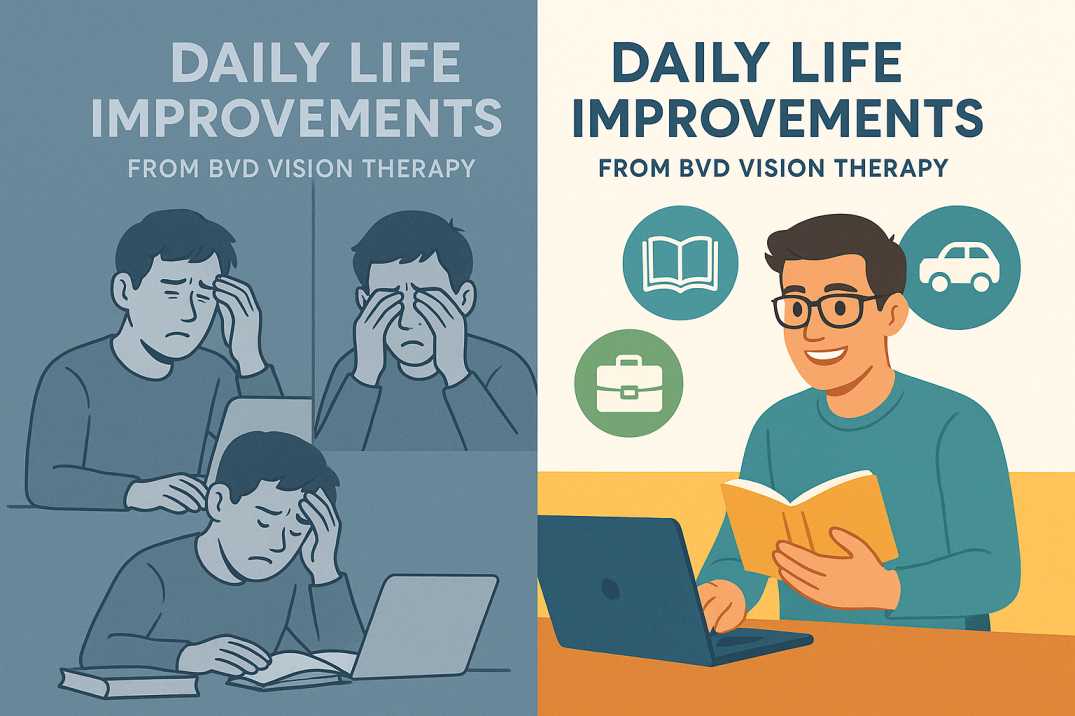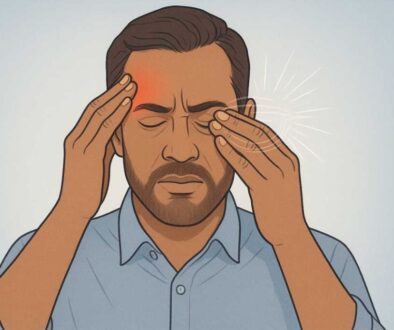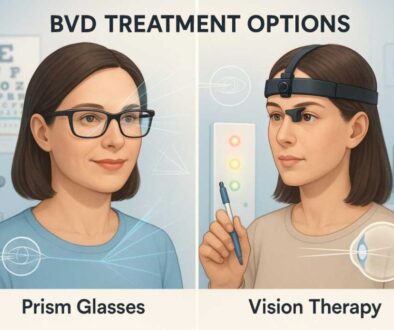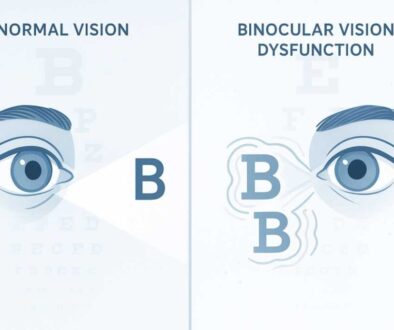Living with BVD: Vision Therapy Changes Everything

Introduction: When Daily Life Becomes a Struggle
Living with Binocular Vision Dysfunction (BVD) extends far beyond occasional visual discomfort—it fundamentally alters how individuals navigate their daily existence. For millions of Americans experiencing this condition, routine activities that others consider effortless become sources of frustration, fatigue, and functional limitation.
BVD represents a complex visual processing disorder in which the eyes struggle to work together efficiently, resulting in a cascade of symptoms that ripple through every aspect of daily life. Unlike simple refractive errors corrected with glasses, BVD affects the intricate coordination between both eyes and the brain’s visual processing centers, resulting in symptoms that often masquerade as other conditions.
Research indicates that 10-20% of the population suffers from some form of binocular vision dysfunction, with some studies suggesting that as many as 56% of adults and adolescents show symptoms that may interfere with their everyday lives. Despite its prevalence, BVD remains frequently undiagnosed, leaving individuals to struggle with unexplained symptoms that traditional eye care often fails to address.
This comprehensive analysis examines the real-world impact of living with BVD. It reveals how evidence-based vision therapy interventions can fundamentally transform daily function, productivity, and overall quality of life.
Understanding BVD’s Hidden Impact on Daily Activities
FAQ: Common Questions About Living with BVD
Q: What does living with BVD feel like daily? A: Living with BVD means experiencing constant visual stress that affects everything from reading morning emails to driving safely. Simple tasks become overwhelming due to eye strain, headaches, and difficulty focusing.
Q: How does BVD impact work productivity?
A: BVD can reduce workplace efficiency by 30-50% due to computer vision syndrome, difficulty concentrating during meetings, and increased fatigue throughout the workday.
Q: Can children with BVD succeed in school? A: Yes, but untreated BVD often mimics learning disabilities. With proper vision therapy, academic performance typically improves dramatically.
The Cascade Effect: How BVD Disrupts Daily Function
The impact of BVD extends beyond isolated visual symptoms, creating what researchers term a “cascade effect” throughout daily activities. When the visual system expends excessive energy attempting to maintain binocular fusion, it depletes cognitive resources needed for other tasks, resulting in:
Primary Functional Disruptions:
- Cognitive Load Increase: Up to 40% more mental energy required for visual tasks
- Attention Deficits: Reduced ability to sustain focus during reading or detailed work
- Processing Speed Reduction: Slower completion of visually-dependent activities
- Fatigue Acceleration: Earlier onset of exhaustion during routine daily tasks
Secondary Life Impact:
- Academic Performance: Reading comprehension and mathematical problem-solving difficulties
- Professional Productivity: Reduced workplace efficiency and increased error rates
- Social Participation: Avoidance of group activities requiring sustained visual attention
- Emotional Well-being: Increased anxiety and frustration related to unexplained symptoms
Common Morning Struggles Include:
- Difficulty focusing on smartphone screens or tablets
- Headaches that begin immediately upon waking
- Feeling disoriented when moving from a dim bedroom to a bright kitchen
- Trouble reading medication labels or following recipe instructions
- Eye strain when checking emails or planning the day
Workplace Productivity: When Professional Performance Suffers
The impact of BVD extends beyond visual function, affecting overall quality of life and making it harder to engage in work productively. For adults living with BVD, the workplace presents unique challenges that can significantly impact career advancement and job satisfaction.
Professional Challenges Include:
- Computer vision syndrome symptoms that worsen throughout the workday
- Difficulty maintaining focus during long meetings or presentations
- Problems with depth perception affecting manual tasks or driving
- Increased fatigue leading to decreased afternoon productivity
- Avoiding tasks that require sustained visual attention
Family Life: The Emotional Toll of Visual Dysfunction
Living with BVD doesn’t just affect the individual—it impacts entire families. Parents with BVD may struggle to help children with homework, participate in school activities, or enjoy family outings that involve visual demands.
Family Impact Areas:
- Difficulty reading bedtime stories or helping with schoolwork
- Avoiding family activities like sports events or concerts due to visual stress
- Increased irritability and fatigue affecting family relationships
- Children may develop anxiety about their parents’ recurring symptoms
- Social isolation as a visual symptom makes group activities challenging
How Vision Therapy Addresses Daily Life Challenges
FAQ: Vision Therapy for Daily Living
Q: How long before I see improvements in daily activities? A: Most patients notice initial improvements within 4-6 weeks, with significant daily life changes typically occurring by week 12 of consistent vision therapy.
Q: What daily activities improve most with vision therapy? A: Reading comfort, computer work endurance, driving confidence, and sustained attention show the most dramatic improvements after BVD treatment.
Neuroplasticity and Vision Rehabilitation
Modern vision therapy leverages the brain’s neuroplasticity—its ability to form new neural connections throughout life—to address BVD at its neurological foundation. Unlike traditional approaches that focus solely on optical correction, comprehensive vision therapy targets the neural pathways responsible for binocular coordination.
Evidence-Based Treatment Mechanisms:
- Binocular Integration Training: Exercises that strengthen the brain’s ability to merge images from both eyes
- Vergence Rehabilitation: Targeted activities that improve the eyes’ ability to converge and diverge accurately
- Accommodation Therapy: Training that enhances focusing flexibility across different distances
- Visual Processing Enhancement: Activities that improve the speed and accuracy of visual information processing
Research from the National Eye Institute demonstrates that 75% of children who received weekly office-based vision therapy with daily home exercises experienced significant improvement in convergence within 12 weeks, with benefits extending to academic performance and overall quality of life.
Key Components of BVD Vision Therapy:
- Binocular coordination exercises that teach the eyes to work together seamlessly
- Vergence training to improve focusing flexibility at different distances
- Visual processing activities that enhance brain-eye communication
- Spatial awareness exercises that restore depth perception accuracy
- Accommodation training that reduces focusing fatigue
Real-World Therapy Applications
Effective BVD vision therapy goes beyond clinic sessions, incorporating daily life situations that directly address functional challenges:
Workplace Integration Exercises:
- Computer-based binocular fusion activities
- Distance-to-near focusing drills mimicking office tasks
- Peripheral awareness training for meeting participation
- Sustained attention activities that build visual endurance
Home Life Applications:
- Reading therapy programs that restore comfortable book enjoyment
- Kitchen task simulations that improve depth perception for cooking
- Driving preparation exercises that enhance visual stability
- Hobby-related visual skills training for crafts, sports, or music
Transformative Success Stories: Life After BVD Treatment
FAQ: Real Patient Outcomes
Q: Do adults see the same success as children with vision therapy? A: Yes, recent research shows that 25% of adults achieved ≥2 lines of visual acuity improvement after just 12 weeks of treatment, with benefits maintained long-term.
Q: What percentage of patients experience life-changing results? A: Studies show a 72% cure rate with vision therapy, while an additional 19% experience significant improvement in daily functioning.
Academic Achievement: From Struggling Student to Honor Roll
Research shows that 75 percent of children who had weekly office-based vision therapy, coupled with 15 minutes of at-home exercise five days a week, experienced significant improvement in their convergence in 12 weeks. Students experiencing this transformation often report:
- Improved reading comprehension and speed
- Better handwriting and spatial organization
- Increased classroom attention and participation
- Enhanced test-taking performance due to reduced visual fatigue
- Greater confidence in challenging academic subjects
Professional Success: Career Advancement After Treatment
Studies indicate that at least 10% to 20% of the population suffers from Binocular Vision Dysfunction, with some research suggesting that as many as 56% of adults and adolescents show some symptoms of BVD that may be interfering with their everyday lives.
Professional improvements following BVD vision therapy frequently include:
- Increased work productivity and accuracy
- Ability to work longer hours without visual fatigue
- Enhanced presentation and meeting participation
- Improved driving safety for work commutes
- Greater confidence in visually demanding job responsibilities
Family Relationships: Restored Connection and Participation
When visual symptoms improve through therapy, family dynamics often transform dramatically. Parents report being able to:
- Engage actively in children’s educational activities
- Participate in family sports and recreational activities
- Enjoy social gatherings without visual stress-induced irritability
- Share hobbies and interests that were previously avoided
- Provide better emotional support when not managing constant symptoms
Advanced Treatment Approaches for Daily Life Integration
Technological Integration in Modern Vision Therapy
Contemporary BVD treatment increasingly incorporates advanced technologies that enhance treatment precision and accelerate functional improvements:
Digital Therapy Platforms:
- Computer-based binocular coordination exercises with real-time feedback
- Virtual reality applications that simulate challenging visual environments
- Eye-tracking systems that provide objective progress monitoring
- Mobile applications for consistent home-based therapy compliance
Advanced Diagnostic Capabilities:
- High-resolution binocular function analysis
- Quantitative assessment of visual processing efficiency
- Objective measurement of treatment progress through standardized testing
- Predictive modeling for treatment outcome optimization
Daily Benefits of Micro-Prism Correction:
- Immediate reduction in headaches and eye strain
- Improved driving safety and confidence
- Better workplace productivity from the first day of wear
- Enhanced reading comfort and comprehension
- Reduced anxiety in visually demanding situations
Lifestyle Modifications That Enhance Therapy Success
Simple changes to daily habits can make a big difference for individuals with BVD, including taking regular breaks during screen use, ensuring proper lighting for reading and work, and adjusting workstation ergonomics to reduce visual strain.
Essential Daily Modifications:
- Lighting optimization: Adequate, even lighting reduces visual system stress
- Screen ergonomics: Proper monitor positioning and break schedules
- Visual hygiene: Regular eye movement exercises throughout the day
- Stress management: Techniques that reduce overall system tension
- Sleep quality: Ensuring adequate rest for visual system recovery
The Long-Term Journey: Maintaining Progress and Preventing Regression
Building Visual Stamina for Sustained Daily Function
Vision therapy success extends beyond symptom elimination—it builds visual stamina that allows individuals to handle increasingly demanding daily activities without regression.
Progressive Skill Development:
- Week 1-4: Basic binocular stability and comfort
- Week 5-12: Improved focusing, flexibility, and endurance
- Week 13-20: Advanced spatial processing and complex task integration
- Week 21+: Maintenance training and lifestyle optimization
Preventing Symptom Return Through Daily Practice
Long-term success requires ongoing commitment to visual wellness practices:
Daily Maintenance Activities:
- 5-minute morning visual warm-up routines
- Workday break exercises that maintain binocular stability
- Evening relaxation techniques that restore visual system balance
- Weekly challenging activities that maintain therapy gains
- Regular progress monitoring with vision therapy professionals
Economic Impact Analysis: The Hidden Costs of Untreated BVD
Understanding the financial implications of living with untreated BVD provides crucial context for treatment investment decisions. Economic analysis reveals substantial direct and indirect costs associated with unmanaged binocular vision dysfunction.
Direct Healthcare Costs
Annual Medical Expenses:
- Average healthcare utilization increases by 40-60% due to misdiagnosed symptoms
- Emergency department visits for unexplained headaches and dizziness
- Multiple specialist consultations (neurology, psychiatry, internal medicine)
- Prescription medications for symptom management rather than underlying cause treatment
- Alternative therapy expenses (massage, chiropractic, acupuncture) for related tension and pain
Indirect Economic Impact
Educational Costs:
- Academic underachievement requiring additional tutoring services ($2,000-$5,000 annually)
- Extended educational timelines due to learning difficulties
- Potential impacts on college admission and scholarship opportunities
- Special education services and accommodations
Professional Productivity Losses:
- Reduced workplace efficiency is estimated at 20-35% for knowledge workers
- Increased absenteeism related to visual symptoms (average 8-12 days annually)
- Limited career advancement opportunities in visually demanding fields
- Potential disability claims and workplace accommodation costs
Family System Impact:
- Parental work disruptions for medical appointments and school meetings
- Family stress and relationship counseling expenses
- Reduced participation in family activities and social engagement
Quality of Life Improvements:
- Increased work productivity and earning potential
- Reduced medical expenses from chronic headaches and related symptoms
- Enhanced educational or career advancement opportunities
- Improved family relationships and social participation
- Greater independence in daily activities
Hidden Cost Savings:
- Fewer sick days due to vision-related symptoms
- Reduced spending on ineffective treatments or medications
- Lower risk of accidents due to improved visual function
- Decreased need for academic or workplace accommodations
- Enhanced mental health, reducing therapy or counseling needs
When to Seek Professional Help: Recognizing the Need for Change
Red Flags That Indicate BVD Is Controlling Your Life
Living with BVD often involves gradual adaptation that masks the severity of daily limitations. Consider a professional evaluation if you experience:
- Avoiding reading or computer work due to visual discomfort
- Chronic fatigue that seems disproportionate to daily activities
- Headaches that worsen with visual tasks and improve with rest
- Social withdrawal from visually demanding activities
- Academic or work performance below your intellectual capabilities
Finding Specialized BVD Treatment
Not all vision care providers have the specialized training necessary for effective BVD treatment. When seeking help:
Look for Practitioners With:
- Specialized neuro-optometric or developmental optometric training
- Extensive experience with binocular vision disorders
- Access to advanced diagnostic equipment for BVD assessment
- Comprehensive vision therapy programs, not just corrective lenses
- Success stories and testimonials from similar cases
The Future of BVD Treatment: Emerging Technologies and Approaches
Technological Advances in Vision Therapy
The field of BVD treatment continues evolving with new technologies that enhance daily life integration:
Emerging Technologies:
- Virtual reality-based therapy programs that simulate real-world challenges
- Advanced eye-tracking systems that provide precise progress monitoring
- Home-based digital therapy platforms that extend clinic treatment
- Specialized apps that provide daily exercise reminders and progress tracking
- Improved micro-prism technologies that offer more precise correction
Research and Development in Daily Life Applications
Current research focuses on making BVD treatment more accessible and effective for daily life challenges:
- Studies on workplace productivity improvements following vision therapy
- Research on academic performance enhancement in students with BVD
- Investigation of family relationship improvements after treatment
- Analysis of long-term quality of life outcomes
- Development of predictive models for therapy success
Taking the First Step: Your Path to Improved Daily Living
Diagnostic Excellence in BVD Assessment
Accurate BVD diagnosis requires specialized expertise and comprehensive evaluation protocols that extend far beyond standard optometric examinations. The complexity of binocular vision dysfunction necessitates a detailed assessment of multiple visual system components.
Essential Diagnostic Components:
Comprehensive History Assessment:
- Detailed symptom timeline and pattern analysis
- Academic or professional performance correlation
- Previous treatment history and outcomes
- Family history of visual processing difficulties
- Associated symptoms (headaches, motion sensitivity, reading avoidance)
Advanced Binocular Function Testing:
- Precise measurement of eye alignment under various conditions
- Assessment of convergence and divergence capabilities
- Evaluation of accommodation (focusing), flexibility, and stamina
- Testing of fixation stability and tracking accuracy
- Analysis of depth perception and spatial processing abilities
Functional Vision Assessment:
- Real-world task simulation and performance measurement
- Sustained visual attention capability evaluation
- Visual processing speed and accuracy testing
- Integration of visual information with cognitive demands
Essential Diagnostic Components:
- Detailed symptom history, including daily life impacts
- Binocular vision function testing under various conditions
- Assessment of visual processing efficiency
- Evaluation of how symptoms affect work, school, and family life
- Identification of specific daily activities that trigger symptoms
Creating Your Personalized Treatment Plan
Successful BVD therapy is highly individualized, taking into account:
- Your specific symptom pattern and severity
- Daily activities that are most important to you
- Work, school, or family demands that must be accommodated
- Previous treatment history and what has or hasn’t helped
- Personal goals for improvement and timeline expectations
Additional Resources and Citations
Authoritative Sources and Research References:
- National Eye Institute – Convergence Insufficiency Treatment Trial
Archives of Ophthalmology, 2008
Link: https://www.nei.nih.gov/learn-about-eye-health/eye-conditions-and-diseases/convergence-insufficiency
Key Finding: 75% of children who received weekly office-based vision therapy with daily home exercises experienced significant improvement in convergence within 12 weeks. This landmark multi-center study established the gold standard for vision therapy effectiveness research. - PubMed Central – Effectiveness of Vision Therapy in School Children
PMC Research Database, 2017
Link: https://www.ncbi.nlm.nih.gov/pmc/articles/PMC5537142/
Key Finding: Comprehensive analysis showing accumulated cure rates of 72%, improvement rates of 19%, and failure rates of only 9% for vision therapy programs. This meta-analysis provides the most current success rate data for binocular vision dysfunction treatment. - American Optometric Association – Binocular Vision Disorders
Clinical Practice Guidelines, 2024
Link: https://www.aoa.org/healthy-eyes/eye-and-vision-conditions/binocular-vision
Key Finding: Research indicates that 10-20% of the population suffers from some form of binocular vision dysfunction, with symptoms often misdiagnosed or overlooked in routine eye examinations. This resource provides comprehensive diagnostic criteria and treatment protocols.
Conclusion: Evidence-Based Transformation Through Specialized Care
The journey from living with debilitating BVD symptoms to experiencing comfortable, efficient binocular vision represents one of the most significant quality-of-life improvements achievable through non-invasive medical intervention. Comprehensive research demonstrates that specialized vision therapy provides measurable, lasting benefits that extend throughout all aspects of daily functioning.
The Paradigm Shift: From Symptom Management to Functional Restoration
Traditional approaches to vision-related difficulties often focus on symptom management rather than addressing underlying neurological coordination problems. Modern vision therapy represents a fundamental paradigm shift toward comprehensive rehabilitation that targets the root causes of binocular dysfunction.
The accumulated evidence from peer-reviewed research, combined with decades of clinical experience, establishes vision therapy as the most effective treatment modality for BVD. With cure rates reaching 72% and improvement rates extending to over 90% of treated individuals, the potential for life transformation through specialized care has never been more promising.
The Ripple Effect: Beyond Visual Function
Successfully treated BVD patients consistently report improvements that extend far beyond visual comfort. Enhanced academic performance, increased workplace productivity, strengthened family relationships, and restored confidence in daily activities represent the comprehensive benefits of addressing binocular vision dysfunction through evidence-based treatment protocols.
The transformation occurs not merely in how individuals see, but in how they engage with their world. Students discover academic capabilities previously masked by visual processing difficulties. Professionals achieve career goals that seemed unattainable due to visual limitations. Families reconnect through shared activities that were previously avoided due to visual stress.
Moving Forward: The Path to Transformation
For individuals currently experiencing the daily challenges associated with BVD, the evidence provides clear direction: specialized vision therapy offers the most effective pathway to functional improvement. The key lies in accessing care from practitioners with specific expertise in binocular vision disorders and comprehensive treatment protocols.
The decision to pursue BVD treatment represents an investment in quality of life that extends across academic, professional, and personal domains. With success rates exceeding 90% for some improvement and the potential for complete symptom resolution in nearly three-quarters of patients, the opportunity for transformation through specialized care provides hope for millions of individuals currently struggling with undiagnosed or inadequately treated binocular vision dysfunction.
Your vision affects every interaction, every opportunity, and every experience that defines daily life. When binocular dysfunction is addressed through expert care, the improvements ripple through all aspects of existence, restoring not just visual function but the full potential for engagement with the world around you.
For more information about specialized BVD treatment and how vision therapy can transform your daily life, contact Cook Vision Therapy Center. Our 40+ years of experience in exclusive vision therapy practice have helped thousands of patients reclaim comfortable, efficient vision for improved daily living.
FAQs
-
-
BVD occurs when your eyes don’t align properly, causing double vision, headaches, dizziness, and difficulty focusing.
-




